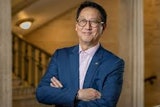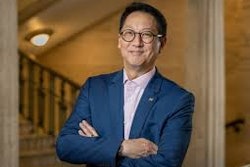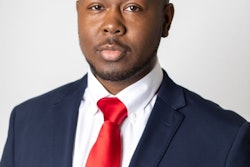Postdoctoral Fellowships are increasingly being seen as a recruiting tool to improve faculty diversity.
|
| Dr. Roberto M. Aguilar, a researcher at the University of California, Irvine, says landing a postdoctoral fellowship with the UC President’s Postdoctoral Fellowship program has put him in contention for a tenure-track post. |
Dr. Roberto M. Aguilar has no doubt that landing a postdoctoral fellowship through the University of California President’s Postdoctoral Fellowship program has put him in serious contention to pursue a tenure-track faculty position at a major research university. Working on neurobiology research at the Reeve-Irvine Research Center at the University of California, Irvine, has proved to be a gratifying accomplishment for Aguilar, a first-generation college graduate.
“Without this fellowship it wouldn’t be possible for me to be considered by the research schools that have expressed interest in my research,” Aguilar says.
“There’s not that many places in the United States doing the research that’s done at the Reeve center … I’m very fortunate to be here.”
At the University of California, Santa Barbara, Dr. Lachelle Hannickel, another current participant in the UC President’s Postdoctoral Fellowship program, has been able to spend the time since earning her Ph.D. in French in 2007 working on journal articles, a book manuscript and her job search. She says she benefited by attending professional development workshops along with other UC postdoctoral fellows as well as getting advice from her designated faculty mentor.
|
| Sibby Anderson-Thompkins, Director, Office of Postdoctoral Affairs, University of North Carolina-Chapel Hill |
“The postdoc really provides you the time to get your professional development underway enough so that when you do become a professor you’re starting off on stronger legs,” Hannickel says.
She notes that a postdoctoral fellowship can potentially help raise a young scholar’s competitiveness level, given that newly minted Ph.D.s in the humanities and social sciences are often competing against people who have had doctorates for several years but who have not yet held a tenure-track job. In the fields in which Hannickel seeks a tenure-track position, which include departments and programs in French, women’s studies, ethnic studies and Black studies, there have been 150 to 200 applicants for every job opening, Hannickel says faculty recruiters told her.
“These are the numbers applying for jobs at almost every type of academic institution that have tenure-track positions,” Hannickel says.
Despite U.S. higher education facing a wave of retirements by older baby boomer and World War II-era born professors, there remain large pockets in the academic work force, such as life science faculties at research universities and humanities/social science faculties across all of academia, where tenure-track jobs are scarce and the market is saturated with Ph.D.s seeking those positions.
“Even though we have lots of studies that predicted that faculty members were going to retire, people have not retired. And there is a shortage of tenure-track jobs. There are teaching jobs, but not great growth in terms of tenure-track jobs,” says Sibby Anderson-Thompkins, director of the Office of Postdoctoral Affairs at the University of North Carolina-Chapel Hill.
For young scholars, such as Aguilar and Hannickel, the postdoctoral fellowship represents almost as important a launching pad for an academic career as the Ph.D. programs that initially trained them. In recent years, advocates for faculty diversity have begun to push for postdoctoral programs that target underrepresented minorities with the overall goal of increasing their representation as tenure-track faculty members. Both Aguilar, who is Mexican American, and Hannickel, a biracial woman whose father is Black and mother is White, benefited from the UC President’s Fellowship because it seeks to increase underrepresented minorities at the university faculty level.
The STEM Picture
Dr. Anthony DePass, assistant vice president for faculty research development and an associate professor of biology at Long Island University-Brooklyn, is among a growing group of scientists and academic administrators who have taken on the task of improving postdoctoral opportunities for underrepresented minorities in the science, technology, engineering and mathematics (STEM) disciplines. This past summer, DePass, as chairman for the Minority Affairs Committee for the American Society for Cell Biology (ACSB), along with the American Association for the Advancement of Science (AAAS), organized a career development workshop for 25 young minority faculty members and postdoctoral fellows at the AAAS headquarters in Washington, D.C. The workshop included seminars on professional conduct, time management, grant writing and mentoring, along with opportunities for participants to have their research manuscripts and grant proposals reviewed by senior scientists.
“We have tried to provide training and mentorship for underrepresented minorities who are in either postdoctoral positions or junior faculty positions to better ensure their success at these research institutions or at other types of institutions,” DePass explains.
DePass describes the recent evolution of life sciences research as one that has rapidly increased the numbers of postdoctoral fellowships, primarily at research intensive universities, but has not proportionately expanded the number of tenure-track faculty positions. He contends that underrepresented minorities have largely seen career opportunities at minority-serving institutions, which tend not to be research-intensive, and other nonresearch intensive institutions, open up, but they have been at a disadvantage at securing jobs at the top research universities.
“The robust capacity in the training population was not matched by increases in tenure-track slots at our major research universities, resulting in a glut in the labor market and increased competition for professional advancement in academic research. Combine this reality with a system that has had difficulties in demonstrating its capability for training and placing underrepresented minorities in coveted research faculty positions, and the need is clear for the type of training that we provided in this workshop,” DePass notes.
Dr. Daryl E. Chubin, director of the AAAS Center for Advancing Science and Engineering Capacity, says the workshop he co-organized with DePass proved revealing in that the postdoctoral fellows largely had appointments at major research institutions while the junior faculty participants “would be either in a minority-serving institution or a liberal arts college” and in some cases based in a community college.
|
| Dr. Christine Balance, Postdoctoral Fellow, University of California, Riverside |
“Even though this was a small sample, it does tell you something,” Chubin says. “That immediately gets us wondering about the overall market, opportunities for professionals of color and whether they are any different from the rest. And these (opportunities) are in the life sciences so that’s where the glut of postdocs happens to be.”
DePass says there’s a need to build support programs around postdoctoral fellowships and the junior faculty experience for underrepresented minorities. “We started 30 years ago with this mandate to increase underrepresented minorities at the highest levels in science, as leaders in science, and we assumed that if you want leaders in science you get people with Ph.D.s. So, a lot of the programs that have been designed focused on getting people on the path to the Ph.D. You figure if you get them into graduate school then you’ve done your job,” he explains.
The National Postdoctoral Association (NPA), an organization that represents the interests of postdoctoral fellows, tracks their numbers and seeks to improve working conditions for NPA members who are working in fellowships. In 2003, 7.4 percent of STEM postdoctoral fellows were from underrepresented minority groups, according to the NPA. The National Science Foundation (NSF) reports that, among the 49,201 science, engineering and health postdoctoral fellows at U.S. institutions in 2006, 30,134 were in science fields; 4,623 were in engineering fields; and 14,444 were in health fields.
Data from the University of North Carolina- Chapel Hill may provide a snapshot of how postdoctoral fellowships are distributed at research universities. Out of 969 postdoctoral fellows in the 2007-08 academic year, 492 had appointments in UNC School of Medicine departments. In STEM disciplines under the UNC arts and sciences division, 206 had appointments, and the rest, 271, were scattered among humanities departments, social science departments and academic institutes and centers.
Using Postdoctoral Programs to Attract Minority Faculty
UNC’s Anderson-Thompkins says organizations such as the NPA as well as individual universities and public university systems have grown increasingly interested in how they can strategically develop postdoctoral programs to improve opportunities for underrepresented minorities to gain tenure-track faculty jobs. Since 1983, UNC has maintained a minority postdoctoral program that has helped attract underrepresented minorities to do research and teach at the flagship school. The program, called the Carolina Postdoctoral Program for Faculty Diversity, has brought 132 scholars into two-year fellowships and 42 of them were eventually hired into tenuretrack positions.
The UC President’s Postdoctoral Fellowship program has also offered a model for public university systems to consider. Established in 1984, the two-year UC President’s Postdoctoral Fellowship has helped the UC system attract and hire dozens of minorities from underrepresented groups into tenure-track positions at UC campuses. Encouraged by a hiring incentive, academic departments at UC schools that hire current and past postdoctoral fellows for tenure-track jobs receive funding from the UC president’s budget to help pay the salaries of those new faculty members. Among the UC President’s Postdoctoral Fellows appointed from 2001 to 2006, more than 75 percent have received tenure-track faculty appointments and more than 40 percent have gained faculty appointments at UC campuses, according to UC officials.
Dr. Christine Balance is a current fellow in the UC President’s postdoctoral program in the music department at the University of California, Riverside. A native of southern California who is Filipino American, Balance earned a Ph.D. in performance studies at New York University in 2007 but had been undecided about pursuing a tenure-track professorship while completing her doctorate. When she learned about the UC postdoctoral program she saw it as an opportunity that could enable her relocation to California and give her a shot at landing a tenure-track job as a professor.
“I saw the UC fellowship as a way to get back to California, but also as an opportunity to have the time to develop as an intellectual,” Balance says.
Since starting the fellowship in fall 2007, Balance has accepted an assistant professor position in Asian American studies at the University of California, Irvine, that falls under the hiring incentive program offered through the UC postdoctoral fellowship program.
|
| Dr. Daryl E. Chubin, director of the AAAS’s Center for Advancing Science and Engineering Capacity, says a workshop he helped organize revealed postdocs largely held coveted faculty positions at major research institutions. |
Sought out for her expertise on postdoctoral issues, UNC’s Anderson-Thompkins currently serves in a newly created diversity officer position for the NPA. She says that for a lot of people in the social sciences and humanities, “the postdoc has become attractive because it allows them to maintain a holding pattern where they’re still affiliated with a research institution doing research.”
Young scholars see the time spent during a postdoctoral fellowship providing “some benefit in terms of putting together a book proposal or working on a manuscript. So, it ultimately can make them more attractive and competitive for jobs,” according to Anderson-Thompkins.
© Copyright 2005 by DiverseEducation.com


















